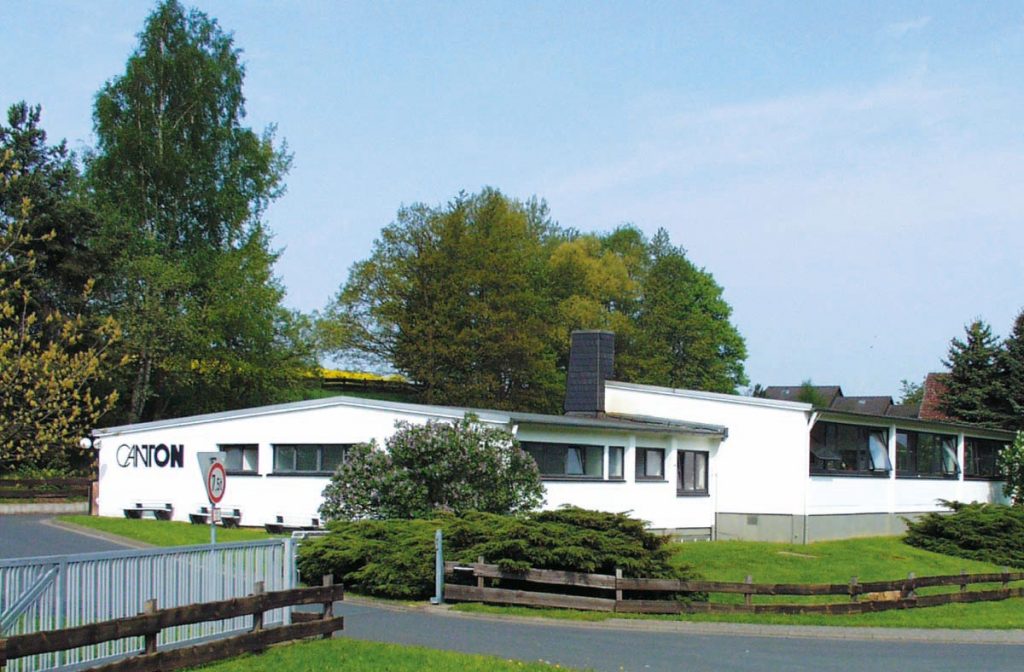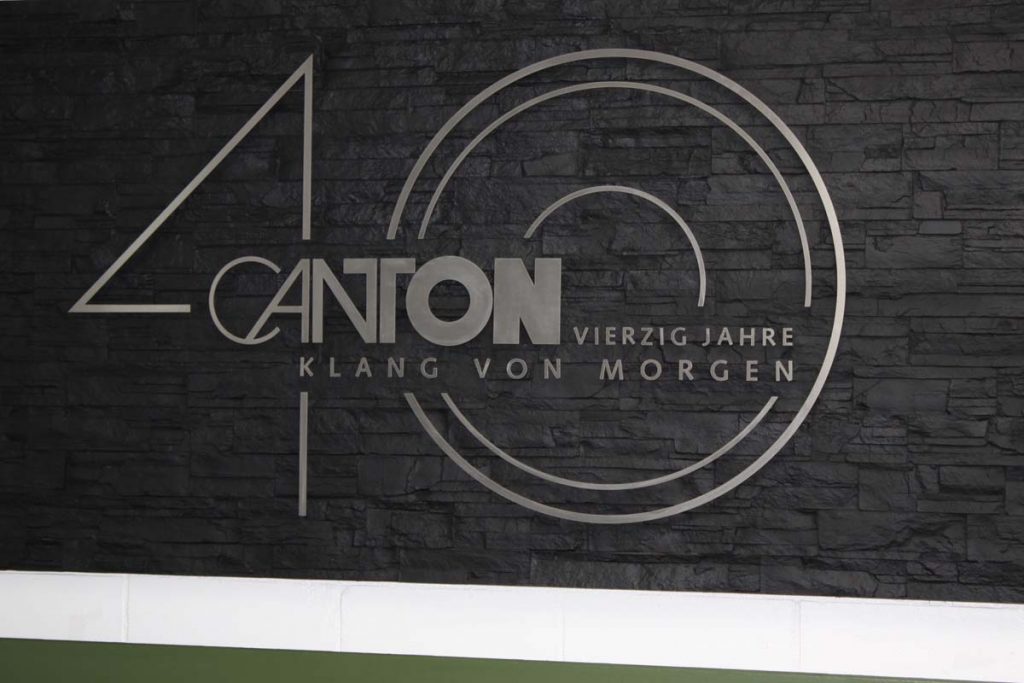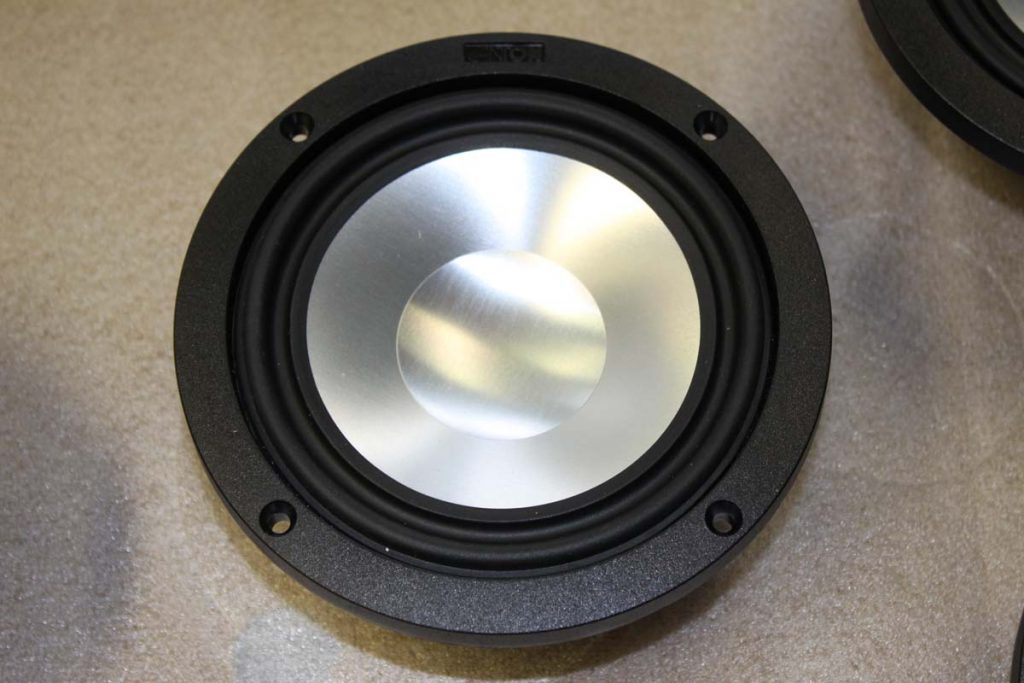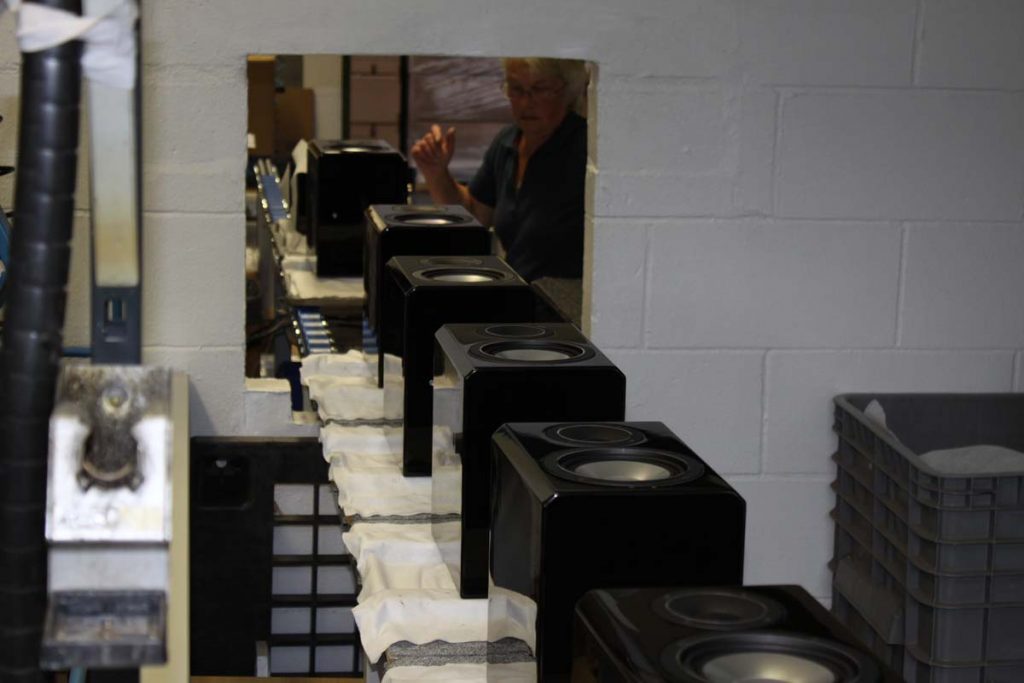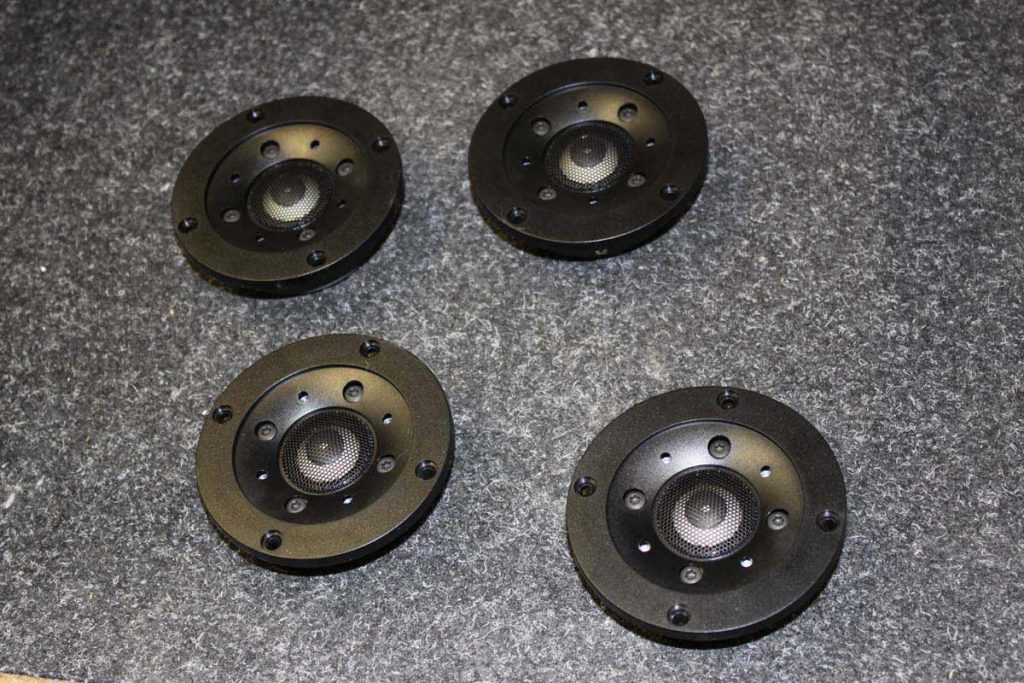From the Small-Town School to Computer-Simulated Speakers
Headed by Guenther Seitz, Canton employs about 200 employees and operates production sites in Niederlauken and the Czech Republic as well as at a US subsidiary in Minneapolis…
People determined to establish a company and find a home for it in a crowded marketplace need to bring something special to the table. Besides fearlessness and expertise, they must, above all, be far-sighted and creative, qualities that also enable them to turn on a dime and open their minds to unconventional thinking. Take Guenther Seitz. Back in 1972, the entrepreneur approached the mayor of Weilrod, a town situated in the Taunus Mountains north of Frankfurt, and asked permission to use a vacant school building in the Niederlauken area of the town as the base for his new company, Canton. At the time, he hadn’t the slightest idea that the company he had just started would become Germany’s largest maker of speakers.
Just a few months before Seitz made his request, three employees of the companies Heco and Braun put their heads together at the Hannover Messe (Trade Fair) and decided to set up their own company. The decision to strike out on their own was a product of their professional frustration that began to build after Heco was acquired by the Rank Arena Group. Seitz, who was head of production, and developer Wolfgang Seikritt, who had worked at Braun until the mid-1960s, were less than excited about the new management team.
They then joined forces with Otfried Sandig, the head of marketing and sales at Braun, and established Canton. The new company’s team was rounded out by Hubert Milbers, who assumed the position of managing director.
The company officially launched its production operation on January 1, 1973, with a team of 35 employees, eight of whom had worked at Heco. Development work for the speakers was initially carried out in employees’ living rooms, a setting that would resemble the location of their future deployment. Despite the company’s humble trappings, it had big plans: The goal was to develop the very best speakers in every single category. And with its very first collection of LE series bookshelf speakers, the company took its initial step toward meeting this goal. The speakers immediately created a buzz in the trade media and among hi-fi enthusiasts. The school building and the teacher’s house, two properties that were rented in the beginning and then purchased, soon became too small for a company that was suddenly growing by leaps and bounds. In the rush to find more space, the company decided to rent every single vacant building in town and store the speakers in a watertight barn until a new factory site could be erected next to the former schoolhouse.
The rapid burst of success produced by the initial speaker series fueled the founders’ ambitions. The result: a decision to develop a receiver equipped with cutting-edge electronic technology. But the Gamma 800R, a product that was produced with painstaking care in England and presented in 1977, turned out to be an expensive business lesson for the new entrepreneurs: As a result of a wide range of equipment defects, the company was ultimately forced to shut down production shortly after it began. This technical and commercial flop turned out to be the exception to the rule, though. New successes and innovative developments followed in rapid succession: In 1979, Canton became the first company to introduce a subwoofer satellite system. This was followed in 1980 by the active three-way floorstanding speakers in the Ergo series that were equipped with hybrid amplifiers using thin-film technology and negative feedback for the bass. The series stunned the editorial staff of the leading trade journal of the time, and the magazine soon had everybody talking about the speakers. Three years later, the company added the Pullman series of car speakers to its product range. In 1986, the active Ergo speakers were replaced by the three- and fourway speakers of the CA series, which applied electronic control engineering to all membranes and was the first European speaker to be outfitted with metal-dome tweeters. It also enhanced its power speaker line with the EC-P1 preamplifier.
In 1995, Canton introduced the Digital 1, the first digitally rectified speakers designed for private hi-fi customers. The speakers won the EISA Hi-Fi Award for innovation presented by the European Imaging and Sound Association, a group of 50 European professional journals. Three years later, the company presented its first surround-sound speaker system that met THX standards. As a result, the compact systems of the Movie series became a sales hit in the home-theater market and a revenue driver for the company. In 2007, the company introduced an alternative, the Digital Movie series, which was equipped with its own virtual-surround solution. Employing a subwoofer and a surround center or two satellites, the company’s solution can simulate a surround sound by distributing the individual channels of a multichannel recording to two channels in a frequency-specific manner. Another innovation was the CD wireless speakers presented in 2005. It was the very first series of high-quality wireless hi-fi speakers. A year later, the company introduced the remote-controlled docking station DSS 303. This station not only plays music stored on iPods and iPhones, but also serves as a charging station, FM tuner and digital alarm clock. In 2011, Canton presented the wireless digital system Your World. With it, a docking station for iPods and iPhones can be combined with an individual active speaker or a speaker pair and a subwoofer. If desired, the system can be expanded with another speaker or connected to a computer or other sound source by using an adapter. An alternative to this equipment is the Musicbox M, a product equipped with a Bluetooth interface as well as cinch and optical inputs. It is a system that packs a docking station, RDS tuner, amplifier and speakers equipped with a virtual surround modus into a single piece of equipment. The Musicbox Air 3 is a streaming speaker that can be operated with a Wi-Fi network or in the direct mode.
Today, Canton employs about 200 people and operates production sites in Niederlauken and the Czech Republic as well as at a US subsidiary in Minneapolis, Minnesota. The company is the German market leader with a share of 25 percent as well as the third-largest speaker manufacturer in Europe. Exports comprise 30 percent to 35 percent of its revenues. From the very beginning, Seitz says, Canton was determined to offer the best products at the best-possible price in all classes and for all tastes while developing products down to the very last detail and shunning any type of standard equipment. All components used in the chassis, from the voice coils and magnets to the cone drivers and audio crossover, are made by the company itself or are produced for Canton by special companies that use tools developed by Canton itself. The cabinets for high-quality lines are made in the company’s own workshops in the Taunus Mountains. But the company’s approach to development work has changed over the years. In the 1990s, it abandoned its practice of developing products by using handmade models and began instead to use computer simulations with special software tools. As part of this work, magnetic-oscillation system programs are used to mechanically optimize drivers. Flaws in the chassis that had to be offset in the past by using complicated crossover systems can be eliminated on the computer right from the start. Once the prototypes have been built on the basis of the simulations, follow-up analysis is conducted to determine if the simulated performance actually can be produced in real life. To conduct measurements down to 150 hertz, the company has been using an anechoic chamber since 1989. Lower frequencies are measured in a near- and far-field analysis. The final sound tests are conducted in a listening room that has all of the qualities of your average living room but is outfitted with asymmetrical walls and, for bass tones, a Helmholtz resonator to ensure as little resonance as possible.
The innovations arising from these software-generated simulations included SC technology, something that was applied for the first time in 1993. Thanks to this trick, the bass response was precisely lowered by more than a full octave. Another advance was DC technology (displacement control) that prevents the uncontrolled oscillation of the bass speaker by suppressing subsonic frequencies. The RC technology (room compensation) that was developed on the basis of SC technology also makes it possible to adjust the speaker sound to the individual acoustical qualities of the listening room. Thanks to this approach, the oscillation characteristics of the front mountings for the low- and midrange membranes were optimized by using a special shape: Given the name wave surround by Canton, this approach generates fewer partial vibrations thanks to its multiple curves and creates room for an exceptionally larger hub. The result: a significantly reduced number of sound-distorting resonances. With the aid of a front plate that employs computer-optimized sound transmission, or transmission front plate, both the omnidirectional sound distribution of the tweeters and their effectiveness in the crossover to the bass midrange were significantly improved. This produced fewer distortions and, thus, a “cleaner” total frequency response.
The first speaker equipped with DC technology and developed largely with the help of analysis and simulation processes was the Karat Reference 2 DC, which was presented in 2002 as the new flagship and a testament of the technical possibilities at the time. Three years later, the new top-of-the-line product, the Vento Reference 1 DC, was rolled out. The trade media were soon gushing about the performance of these speakers. Its successor, the Reference 1.2 DS, was introduced in 2009. Serving as the representative of Canton’s very latest technology, it cleared the way for the newly developed Reference hi-end line. In addition to its special crossover technology, this product line is known for its use of aluminum oxide ceramic cups with transmission front plates in the treble system and its bow-shaped housings of multilayer laminate that contain several interior chambers designed to optimize reinforcement.
Today, Canton’s product range contains more than 500 different models. Aside from the Reference line, which also comprises surround systems and a wall speaker, these products include the Vento series with its bow-shaped, laminated cabinets and the Chrono and Chrono SL, a conventionally designed series equipped with aluminum-manganese tweeters. By comparison, the Chrono SLS series and the Vento line use ceramic tweeters and an acoustically optimized cabinet geometry with flattened edges. The models of the Ergo series, the veteran speakers with the rounded cabinet edges and metal grills that represent design classics in the Canton portfolio, are also equipped with aluminum-manganese tweeters. One of the most successful European lines of speakers includes the GLE series, a product range known for its soft dome tweeters with aluminum spool carriers that are embedded in transmission front plates and its especially small-appearing cabinets. One particularly distinctive and diverse member of the product range is the slender, column-like models of the CD series, with their aluminum or MDF housings and their four different designs. Like the Chrono and Ergo speakers, the tweeters in this line use aluminum-manganese membranes. One of their special features is the four woofers stacked on top of one another in place of one large subwoofer.
The product range also offers several lines of architectural speakers. These include the InWall and InCeiling products, the on-wall speakers of the Plus series, the Atelier series — whose models can be hung on the wall or integrated into it, and the Pro series for outdoor use. One special place in the product line is assumed by the AM 5 compact speaker that can be stood up or hung on the wall: With its linear frequency response and the crystal clear sound reproduction created by it, the AM 5 is designed to be used both as a near-field monitor in studios and at presentations and as a hi-fi, TV and computer speaker.
When Canton was founded in 1972, the Stuttgart-based company Wega Radio GmbH was brought in as a silent investment partner. But the alliance came to an end when Sony acquired the company in 1975 and the new owner became a Canton competitor by producing its own line of speakers at the Wega plant in Fellbach. Today, Seitz is the last remaining member of the original four-person team. He serves as the company’s sole owner, and his son Achim now helps him run the business. Soon after the company was founded, Canton’s first managing director, Hubert Milbers, headed off to live in Brazil where he set up his own speaker brand. Then, in 1982, Development Head Wolfgang Seikritt left Canton as a result of professional differences of opinion and established his own speaker company, AXIOM. In 1984, AXIOM was integrated into ELAC. Seikritt has now passed away, just like Otfried Sandig, who headed sales and marketing until he retired in 1999.
While searching for the right name for their new brand, the company’s founders came up with the idea of combining the first syllable of the Latin verb cantare (to sing) with the German word for sound, Ton. After starting production at the beginning of 1973, it took a year for the growing company to replace its provisional logo with something more professional. Christof Gassner, a Swiss graphic designer based in Frankfurt, was asked to develop a logo that not only fit the products, but also expressed the musical theme contained in the company’s name. The result was a logo using the Avant Garde font created by Herb Lubalin in which the boldness of the letters acts a crescendo moving from left to right. The division hinted at between the letters “N” and “T” in the center of the name represents the principle of stereophony. Gassner says the logo also expresses the various pitches of music. Over the last 20 years or so, Gassner has designed many other works for the speaker maker, winning several awards in the process.
Volume up or down? A very quick interview with Guenther Seitz where we wanted him to respond as fast as possible.
Volume up or down? – Down.
Analog or digital? – Analog.
Tube or transistor? – Tube.
Vinyl or download? – Vinyl.
Cross-country run or gym? – Cross-country run.
Trends or tradition? – Both.
Tea or coffee? – Coffee.
Salad or steak? – Steak.
Wine or beer? – Wine.
Mountains or the sea? – Mountains.
Book or screen? – Book.
Jazz club or opera house? – Jazz club.
Bach or Beatles? – Bach and The Beatles.
Wagner or Wacken? – Wagner.
Stand-by or plug out? – Stand-by.


